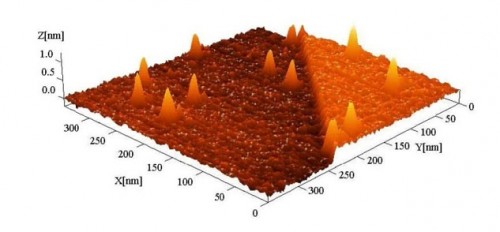Nanostructuring of surfaces
 Slow highly charged ions are a rapidly emerging tool for nanostructuring of surfaces. Their promising qualities are low production cost, high efficiency and the confinement of their interaction with the target material to a very small volume directly at the surface. We have recently shown that the irradiation of CaF2 with individual slow highly charged ions (HCI) leads to the formation of tiny hillocks (see figure at the right) of several tens of nanometer diameter and less than 2 nm height [Phys. Rev. Lett. 100 237601]. CaF2 is an insulating ionic-crystal material commonly used in microelectronics production. Projectiles used for irradiation ranged from Ar11+ with a potential (= internal) energy of 2 keV up to Xe48+ at 80 keV. Upon impact on the surface, the potential energy is released within a very small volume and leads to an extremely localized heating of the target material. Only if the heating is sufficient to locally melt the crystal, a permanent structure is induced which can be analyzed using an atomic force microscope (AFM). The kinetic energy of the projectiles was varied between 10 keV and several hundred keV, without significant changes to the irradiation results. A threshold in potential energy was found for the onset of nanostructuring at around 14 keV (Ar18+ or Xe30+, respectively) for the case of CaF2, explained by the necessary phase transition (melting). Above the threshold, sizes of hillocks depend strongly on the potential energy of the projectiles.
Slow highly charged ions are a rapidly emerging tool for nanostructuring of surfaces. Their promising qualities are low production cost, high efficiency and the confinement of their interaction with the target material to a very small volume directly at the surface. We have recently shown that the irradiation of CaF2 with individual slow highly charged ions (HCI) leads to the formation of tiny hillocks (see figure at the right) of several tens of nanometer diameter and less than 2 nm height [Phys. Rev. Lett. 100 237601]. CaF2 is an insulating ionic-crystal material commonly used in microelectronics production. Projectiles used for irradiation ranged from Ar11+ with a potential (= internal) energy of 2 keV up to Xe48+ at 80 keV. Upon impact on the surface, the potential energy is released within a very small volume and leads to an extremely localized heating of the target material. Only if the heating is sufficient to locally melt the crystal, a permanent structure is induced which can be analyzed using an atomic force microscope (AFM). The kinetic energy of the projectiles was varied between 10 keV and several hundred keV, without significant changes to the irradiation results. A threshold in potential energy was found for the onset of nanostructuring at around 14 keV (Ar18+ or Xe30+, respectively) for the case of CaF2, explained by the necessary phase transition (melting). Above the threshold, sizes of hillocks depend strongly on the potential energy of the projectiles.
We are currently studying a variety of materials with respect to their response to slow highly charged ion irradiation. Among them are insulating materials like LiF, SiO2 or PMMA as well as layered materials like Mica or graphite. The induced structures vary considerably, including hillocks, pits or craters. Some non-topological modifications like a modification of the surface friction were also observed. Generally, the potential energy of the projectiles is the driving force behind the appearance of these structures. Often even a threshold in the potential energy is observed. The ultimate goal behind these studies is to develop a general model for the interaction of slow highly charged ions with insulating materials which is able to explain the appearance of the different structures.
Contact: Robert Ritter
This work was performed as a collaboration between TU-Wien (Institut für Allgemeine Physik and Institute for Theoretical Physics), the Max Planck Institute for Nuclear Physics in Heidelberg (Germany), Forschungszentrum Dresden (Germany) and CIRIL in Caen (France).
Publications:
F. Aumayr, S. Facsko, A. S. El-Said, C. Trautmann and M. Schleberger
Topical Review: Single-ion induced surface nanostructures - A comparison between slow highly-charged and swift heavy ions
Journal of Physics: Condensed Matter 23 (2011) 393001 (23 pages)
A.S. El-Said, R. Heller, W. Meissl, R. Ritter, S. Facsko, C. Lemell, B. Solleder, I.C. Gebeshuber, G. Betz, M. Toulemonde, W. Möller, J. Burgdörfer, and F. Aumayr
Nano-hillocks on CaF2 surfaces created by the potential energy of slow highly charged projectile ions
Physical Review Letters 100 (2008) 237601
F. Aumayr, A.S. El-Said, and W. Meissl
Nano-sized surface modifications induced by the impact of slow highly charged ions – a first review
Nuclear Instruments and Methods in Physics Research B 266 (2008) 2729
C. Lemell, A.S. El-Said, W. Meissl, I.C. Gebeshuber, C. Trautmann, M. Toulemonde, J. Burgdörfer, and F. Aumayr
On the nano-hillock formation induced by slow highly charged ions on insulator surfaces
Solid State Electronics 51 (2007) 1398
A. S. El-Said, W. Meissl, M.C. Simon, J. R. Crespo López-Urrutia, C. Lemell, I. C. Gebeshuber, HP. Winter, J. Ullrich, C. Trautmann, M. Toulemonde, and F. Aumayr
Potential energy threshold for nanohillock formation by impact of slow highly charged ions on a CaF2(111) surface
Nuclear Instruments and Methods in Physics Research B 258 (2007) 167
Back to Ion-surface-interaction


